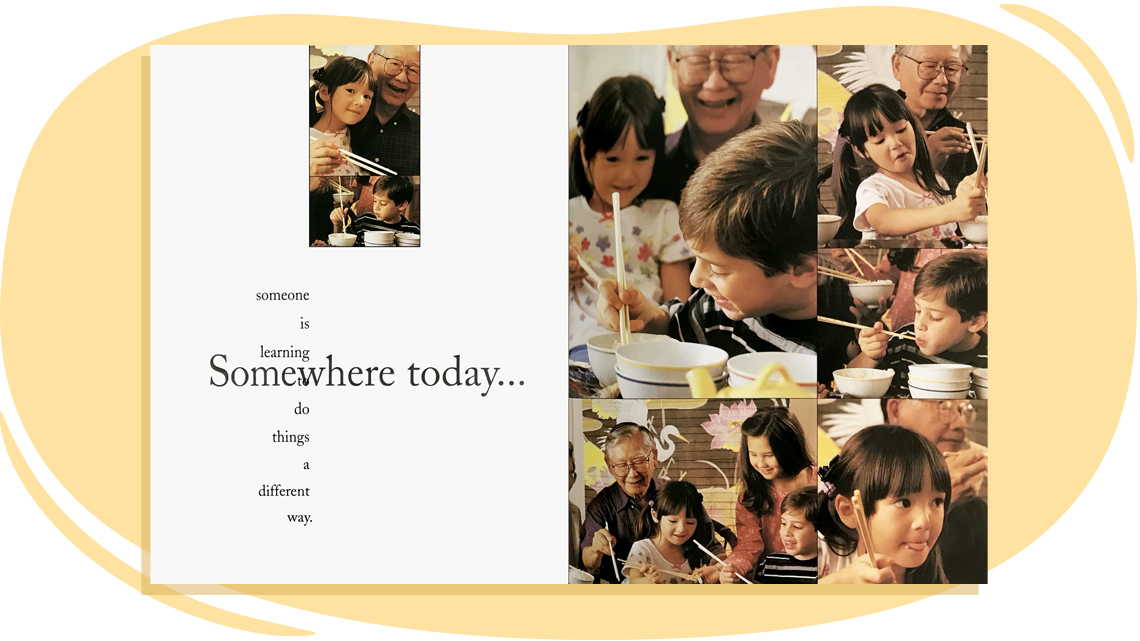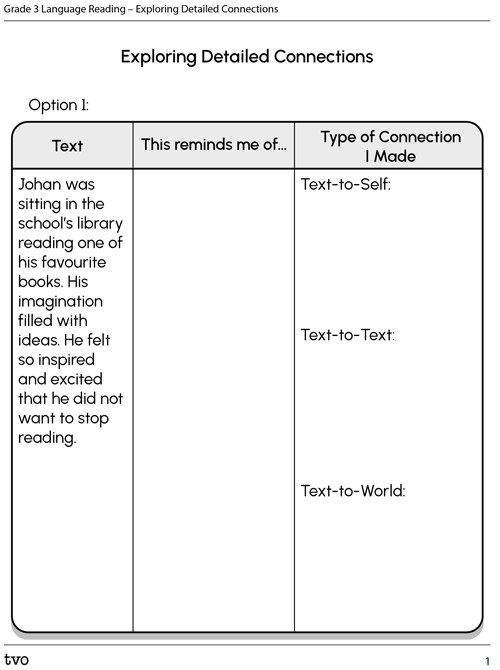Minds On
Making connections in our everyday lives

Imagine winning a prize for a new invention! How would that feel?
If you’ve ever experienced or witnessed anything like this, you can probably imagine how that person might be feeling.
Student Success
Think-Pair-Share
Making connections is a skill we practice every day in our lives to extend our understanding of a situation. Think of how you use this skill in your reading. If possible, discuss your thoughts with a partner.
Note to teachers: See your teacher guide for collaboration tools, ideas and suggestions.
Action
Connecting with text
Learners make connections when they read to deepen their understanding of text.
Three Ways to Connect with Text
Text-to-Self
Text-to-Text
Text-to-World
Text-to-Self

Learners make text-to-self connections when they are connecting what they read to their experiences and knowledge. Some prompts to consider when making text-to-self connections include:
- “This part reminds me of…”
- “If this happened to me, I would…”
Think about other questions you could consider as you are reading to make a text-to-self connection. Record your ideas using a method of your choice.
Use the Text-to-Self Connections in your notebook or using the following fillable and printable document.
| Think about other questions you could consider as you are reading to make a text-to-self connection. Use this space to record your ideas using a brainstorming method or create a journal entry. |
|---|
Press the ‘Activity’ button to access Text-to-Self Connections.
Text-to-Text

Learners make text-to-text connections when they are connecting what they read to other books. Some prompts to consider when making text-to-text connections include:
- “This is different from the other books because…”
- “This is similar to the other books because…”
Think about other questions you could consider as you are reading to make a text-to-text connection. Record your ideas using a method of your choice.
Use the Text-to-Text Connections in your notebook or using the following fillable and printable document.
| Think about other questions you could consider as you are reading to make a text-to-text connection. Use this space to record your ideas using a brainstorming method or create a journal entry. |
|---|
Press the ‘Activity’ button to access Text-to-Text Connections.
Text-to-World

Learners make text-to-world connections when they are connecting what they read to the world around them. Some prompts to consider when making text to world connections include:
- “This is similar to what is happening in the world right now because…”
- “This is different from the things that are happening in the real world because…”
Think about other questions you could consider as you are reading to make a text-to-world connection. Record your ideas using a method of your choice.
Use the Text-to-World Connections in your notebook or using the following fillable and printable document.
| Think about other questions you could consider as you are reading to make a text-to-world connection. Use this space to record your ideas using a brainstorming method or create a journal entry. |
|---|
Press the ‘Activity’ button to access Text-to-World Connections.
Surface vs. detailed connections
Learners think deeply when connecting with text to extend their understanding of the text.
Student Success
Think-Pair-Share
Examine the example provided and ask yourself how surface and detailed connections are different. If possible, discuss your thoughts with a partner.
| Surface Text-to-Self Connection | Detailed Text-to-Self Connection |
|---|---|
| Gita reminds me of myself, because we both have shared goals we would like to achieve. | When Gita won the contest for a new invention, it reminded me of the time I started a recycling program at school. |
Note to teachers: See your teacher guide for collaboration tools, ideas and suggestions.
Student Tips
Types of connections
The surface connection explains that the learner made a text-to-self connection.
The detailed connection explained how Gita’s goal of creating something new reminded the learner of something new they created.
That is what they shared in their connection. It helped us understand the connection even more!
Task 1: Detailed connections
Let’s practice making a detailed connection!

Explore a page from Somewhere Today by Shelley Moore Thomas and make a detailed connection.
Complete the Detailed Connections Activity in your notebook or using the following fillable and printable document.
|
Using the page provided from the book, Somewhere Today by Shelley Moore Thomas with photographs by Eric Futran, share a detailed connection that you can make. Use this space to record your ideas using a brainstorm, or create a journal entry. |
|---|
Press the ‘Activity’ button to access Detailed Connections Activity.
Task 2: Exploring detailed connections

Explore the following snippets of text. Choose 2 of the options and make a detailed text-to-self, text-to-text, or text-to-world connection.
Complete the Exploring Detailed Connections in your notebook or using the following fillable and printable document.
| Text | This reminds me of… | Type of Connection I Made |
|---|---|---|
| Johan was sitting in the school’s library reading one of his favourite ooks. His imagination filled with ideas. He felt so inspired and excited that he did not want to stop reading. |
Text-to-Self: Text-to-Text: Text-to-World: |
| Text | This reminds me of… | Type of Connection I Made |
|---|---|---|
| The tomatoes lay crisp and clean on top of a bed of freshly cut lettuce. Anjali sprinkled a layer of red onions and peppers on top. “Perfect,” she whispered to herself. “Amma will be so proud to see how I made the salad just like she does.” |
Text-to-Self: Text-to-Text: Text-to-World: |
| Text | This reminds me of… | Type of Connection I Made |
|---|---|---|
| “I’m so excited to go out and play!” Armen said. He looked outside and imagined how thrilling it would feel to score another goal at soccer this afternoon. |
Text-to-Self: Text-to-Text: Text- to-World: |

Press the Activity button to access the Exploring Detailed Connections.
Activity (Open PDF in a new tab)Consolidation
Demonstrating our learning

Read Don't Feed The Ducks! or select a book of your choice. As you read, ask yourself questions to make detailed connections to your personal experience and knowledge, other texts, and to the world. Reflect on how making these connections helped you understand the text.
The following component is not optimized for a non-visual experience.
Complete the Text Connections and Reflection Activity in your notebook or using the following fillable and printable document.

Press the Activity button to access the Text Connections and Reflection Activity.
Activity (Open PDF in a new tab)| Text Snippet | My Connection | Type of Connection |
|---|---|---|
| Reflection: How did making detailed connections help me understand the text? | ||
Reflection
How do you feel about what you have learned in this activity? Which of the next four sentences best matches how you are feeling about your learning? Press the button that is beside this sentence.
I feel...
Now, record your ideas about your feelings using a voice recorder, speech-to-text, or writing tool.